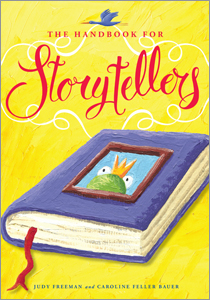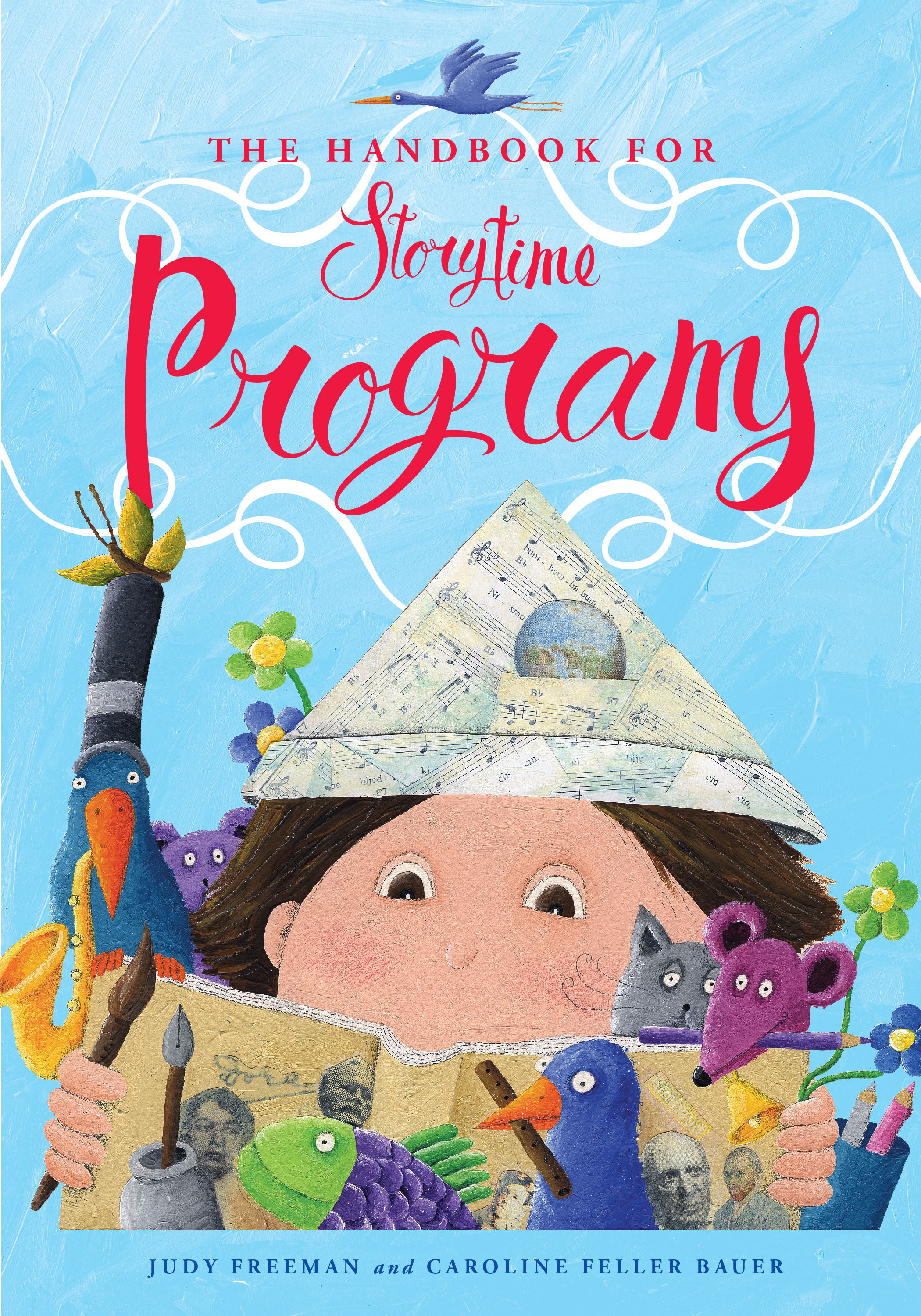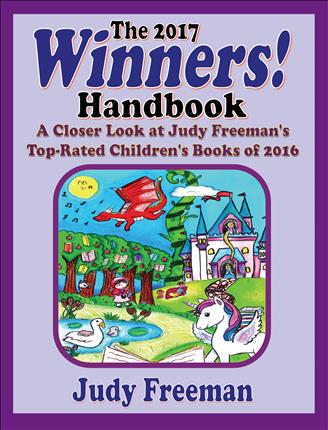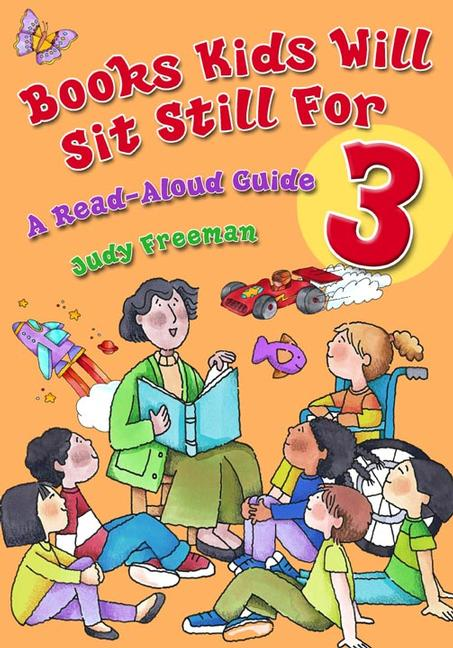 Books Kids Will Sit Still For 3: A Read-Aloud Guide
Books Kids Will Sit Still For 3: A Read-Aloud Guide
Libraries Unlimited, ©2006.
{hardcover $70.00 hardcover; paperback $55.00; 917p.}
For use with ages 3-12.
|
Libraries
Unlimited: Click on Product Search on the left. |
Amazon HARDCOVER PAPERBACK |
Barnes and Noble
HARDCOVER PAPERBACK |
The book starts with a tribute to Judy's late mother, Gladys Freeman ("One Librarian to Another") and continues with extensive, all-new chapters offering entertaining, informative, and instantly useful approaches to reading aloud, storytelling, creative drama, Reader's Theater, and nonstop classroom and library activities across the curriculum. Find out "17 Things You Need to Know to Be a Great School Librarian." Learn how to evaluate a new book. See what it's like to be on the Newbery Committee.
It features a massive, annotated bibliography of 1,705 of her favorite read-aloud titles, all published within the last decade, that will keep children in grades PreK through 6 enthralled. These titles encompass picture books, fiction, folklore, poetry, biography, and nonfiction. Each of the 1,705 entries provides full bibliographic information and a meaty descriptive annotation so you can be reminded of what the book's about if you've read it, or be enticed to pick it up if you haven't.
There's a killer list of up to ten related titles to use for read-alouds, read-alones, thematic units, booktalks, and book discussion groups; and a list of subject headings so you can see where a book might fit into your curriculum, your library program, or your life. Best of all, there are Judy's "Germs": curriculum tie-ins and suggested activities to foster higher level comprehension and critical thinking skills and response to literature, including writing and illustrating prompts, research strategies, discussion questions, and problem solving ideas. Germs are small, pithy, doable ideas to take and, well, "germinate" as you see fit, adding your own spin, talent, and know-how. Take these pithy ideas and grow them into a lesson, a unit, or a good, meaty, meaningful follow-up to use with your kids and have a blast with books.
And finally, there's an updated bibliography of professional books; author, illustrator and titles indexes; and an amazing 100+ page subject index of thousands of subjects for easy access and making nonstop book connections.
"Wow! What a book!" is what Judy is hoping you'll say when you open this comprehensive source of thousands of inspirational literature-based ideas.
Here's what the critics have said so far:
PLANET ESME planetesme.blogspot.com
On August 1, 2006, Esme Raji Codell reviewed the book on her blog. (See: planetesme.blogspot.com/2006_08_01_planetesme_archive.html)
BOOKS KIDS WILL SIT STILL FOR #3: A READ-ALOUD GUIDE by Judy Freeman (Libraries Unlimited) I am actually pulling at the hair on my head, trying to decide where to begin to describe this lifework of one. Amazing. Woman. Starts with a list of seventeen things you need to know to be a good school librarian. Then sections on awards, reading aloud and reading alone, how to integrate books across the curriculum, how to do storytelling and reader's theater, and then, and then, and then! there is an annotated (!!!) list of over a THOUSAND recommendations, divided be genre (such as fiction, fairy tales, poetry, nonfiction), and each recommendation contains a "germ," or a springboard to discussion, a weblink, a project idea...and then, and then, and then! Every title has a mammoth list of related titles! Whooooaaaah. The thing that differentiates this title from other resource books is that this book, despite its dictionary-like girth, despite its encyclopedia-like wealth of knowledge, has personality. You can feel Freeman's enthusiasm and heart on every page, and her desire to pass on everything she knows to you, to make a community of readers a reality in America. Despite its price tag, being from a specialized publisher, I have found this book to be worth every penny, a one-stop shop for all you need to know about children's literature. The admiration I have for this woman and this boggling project brings tears to my eyes.
School Library Journal (October 1, 2006)
"This excellent resource will be a favorite with teachers who need assistance finding quality children's literature, and it will also aid librarians and media specialists. The updated compilation includes over 1700 new titles indexed by author/illustrator, title, and subject. Subjects range from the specific (baseball) to more general (picture books for all ages) to literary elements (point of view). Freeman discusses the underlying reasons behind careful book selection and includes strategies to teach readers and a subject listing to assist teachers with book selection for reluctant readers. She encourages educators to create lifelong learners, library users, and book lovers."-Kathleen Pavin, Purdy Elementary School Library, Fort Atkinson, WI Copyright 2006 Reed Business Information.
Teacher Librarian, October 2006
"Every school library must have a copy of this book, and every teacher needs to know about it to freshen his or her own use of literature in the classroom. There has never been a time in education when better children's literature--fiction and nonfiction--existed, and this book will lead you to the best blooms in the garden of print. Essential as a book selection tool and a source to feature, booktalk, read aloud, and tantalize elementary school children."
Ingram library Services, K-12 Media Shelf Fall 2006--Volume III, Issue 2 (http://www.ingramlibrary.com/MRKNG/K12/0906/delve.html)
"Freeman continues to share her expertise with librarians, teachers, and parents in this new guide to read-alouds. Drawing on her fresh experience as a speaker, book reviewer, and book talker, this guide is more than a revision of the earlier books; there's a substantial amount of new material. New chapters offer informative and entertaining approaches to reading aloud, storytelling, creative drama, Reader's Theater, and classroom and library activities across the curriculum. The annotated read-aloud lists provide hefty, well-written summaries of over 1,700 favorite titles published since 1995, for grades PreK-6, including picture books, fiction, folklore, poetry, biography, and nonfiction. Meaningful activities foster higher level thinking skills and include writing and illustrating prompts, research strategies, discussion questions, and problem-solving ideas. The updated bibliography of professional books is useful and the indexes are comprehensive. This title, part of the series Children's and Young Adult Literature Reference Series, is a valuable resource to turn to again and again. Also available in hardcover."
Book News, Inc./Reference & Research Book News (booknews.com):
Freeman (information and library science, Pratt Institute), an international speaker, former school librarian, writer, and storyteller, provides an entirely new annotated guide to approximately 1,705 titles that can be read aloud to children from grades K-6 (though some are also appropriate for young adults). Categories consist of picture books, fiction, folk and fairy tales, myths and legends, nonsense, poetry, biography, and nonfiction, which she has field-tested. The annotations, arranged alphabetically by author, consist of plot summaries, related titles, subjects, and lesson plan suggestions. Indexes are divided by subject, title, and author/illustrator, and a professional bibliography is included. New features in this edition include tips for being a successful school librarian, and discussions of Freeman's experiences serving on the Newbery Committee, reading aloud vs. reading alone, books across the curriculum (with lists of titles), and using performance in storytelling. Annotation ©2006 Book News, Inc., Portland, OR booknews.com
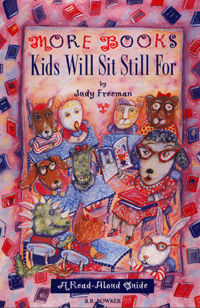 More Books Kids Will Sit Still For: A Read-Aloud Guide
More Books Kids Will Sit Still For: A Read-Aloud Guide
Libraries Unlimited, ©1995.
{$55.00 hardcover; 869p.}
For use with ages 3-12.
| Libraries Unlimited: Click on Product Search on the left. | Amazon HARDCOVER EDITION: |
Barnes and Noble HARDCOVER EDITION: |
There are more than 1,400 extensively annotated, kid-tested titles, with each entry including: bibliographic information, detailed plot statement, practical ideas for sharing the books with children to develop comprehension skills and creativity, related titles for follow-ups on that subject or theme, and subject headings under which the book is listed in the Subject Index.
Annotated Read-Aloud Lists are organized by age level first for fiction, (Preschool-Kindergarten; Kindergarten-Grade 1; Grades 1-2; Grades 2-3; Grades 3-4; Grades 4-5; Grades 5-6), and then: Folk & Fairy Tales, Myths and Legends; Poetry, Nonsense, and Language-Oriented Nonfiction; and Nonfiction and Biography. More Books Kids Will Sit Still For offers a plethora of ideas to incorporate children's books into your program. The all-new text is broken into entertaining, informative chapters on the how and whys of running book-based classrooms and libraries.
 Books Kids Will Sit Still For: The Complete Read-Aloud Guide
Books Kids Will Sit Still For: The Complete Read-Aloud Guide
Libraries Unlimited, ©1990.
{$55.00; 660p.}
For work with ages 3-12.
| Libraries Unlimited: Click on Product Search on the left. | Amazon | Barnes and Noble |
Judy's first book in the series offers inventive ways to introduce children to books. This lively guide recommends over 2,100 read-aloud books-all proven crowd-pleasers, tested through the author's long career as a school librarian and educator. Each entry includes a brief plot summary, literature extension activities, related titles, and subject designations. Annotated Read-Aloud Lists are organized by age level first for fiction, (Preschool-Kindergarten; Kindergarten-Grade 1; Grades 1-2; Grades 2-3; Grades 3-4; Grades 4-5; Grades 5-6), and then: Folk & Fairy Tales, Myths and Legends; Poetry, Nonsense, and Language-Oriented Nonfiction; and Nonfiction and Biography.
Libraries Unlimited, ©2006.
{ISBN 1-591-58477-9; $126.00; 3 volumes}
For work with ages 3-12.
| Libraries Unlimited: Click on Product Search on the left. | Amazon | Barnes and Noble |
Books Kids Will Sit Still For 3: A Read-Aloud Guide is just the latest all-new volume in the Books Kids Will Sit Still For series, which includes Books Kids Will Sit Still For and More Books Kids Will Sit Still For. The three books together constitute a tour of the best of children's literature and how to use it, with a total of more than 5,000 invaluable annotations of exemplary children's books. You can now buy the harcover editions of these books as a 3-book set and save lots of money. (The list price for all 3 books would be $180; the set sells for $126, a $54 savings!)
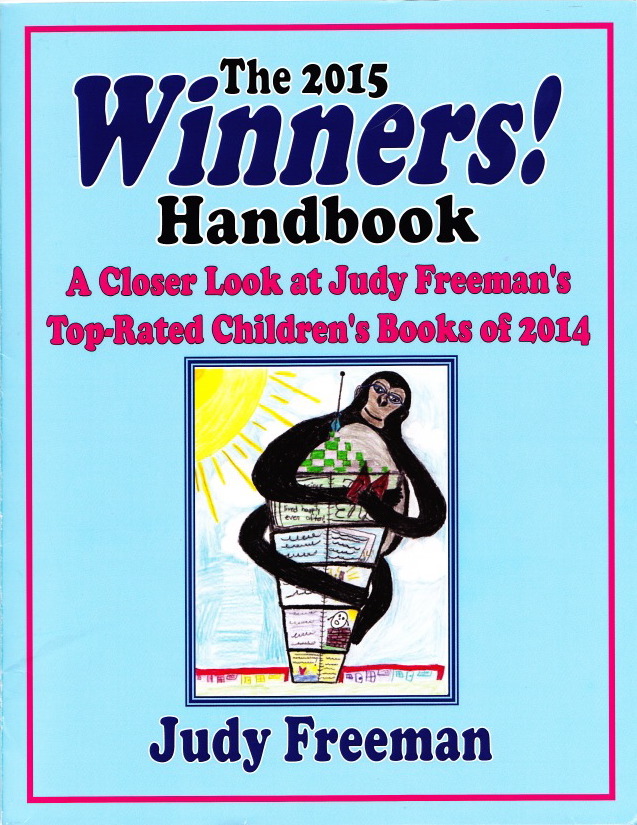 The WINNERS! Handbook: A Closer Look At Judy Freeman's Top-Rated Children's Books of
2014
The WINNERS! Handbook: A Closer Look At Judy Freeman's Top-Rated Children's Books of
2014
by Judy Freeman
Libraries Unlimited, ©2015.
{Paperback $30.00}
Judy Freeman's latest comprehensive handbook weighing in at 250+ pages,
is packed with thoroughly annotated lists of 2014's 100+ best children's
books, lesson plans, worksheets, teacher's guides, stories, songs, Reader's
Theater scripts, a chapter of Internet resources called "Surfing The
Net, and a complete index . This handbook was developed to go with her 31st
Annual Winners! Workshop that she presented across New Jersey in
April 2015. Use this handbook as another handy update of new can't live
without read-aloud titles for Books Kids Will Sit Still For 3. If you
can't make it to Judy's Winners! Workshop or one of her "What's
New in Children's Literature seminars for BER, her all-new yearly editions
of The Winners! Handbook is a mighty good substitute.
Order
form.
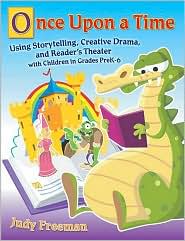 Once Upon a Time: Using Storytelling, Creative Drama, and Reader's Theater with Children in Grades PreK-6
{Paperback; $35.00; 275p.}
For use with ages 3-12.
Once Upon a Time: Using Storytelling, Creative Drama, and Reader's Theater with Children in Grades PreK-6
{Paperback; $35.00; 275p.}
For use with ages 3-12.| Libraries Unlimited | Amazon | Barnes and Noble |
Once Upon a Time! is a winner of the Ninth Annual Anne Izard Storytellers' Choice Award in 2009. Go to http://wlschildrens.wordpress.com/anne-izard-storytellersaward/. The Anne Izard Storytellers' Choice Award was established in 1990 to honor Anne Izard, noted storyteller, librarian and Children's Services Consultant in Westchester County, New York. The award highlights distinguished titles in the field of storytelling published for children and adults, and promotes the riches of storytelling to even wider audiences. Here is their citation about Judy's book:
"For the novice to experienced storyteller, here is a resource jam-packed with one idea after another and "field tested" so they can be used with confidence. Included are booklists, how-to's, some full texts of tales, songs and stories in Reader's Theater format-a treasure trove for all!"
Chapters include:
- Getting Started with Storytelling
- Judy Freeman's Songbook: Including Songs, Chants, Riddles, and Plenty of Nonsense
- Judy Freeman's Storybook: Tales You can Hear Today and Tell Tomorrow
- 400+ Children's Books Every Storyteller Should Know
- Getting Started with Creative Drama and Reader's Theater
- 100+ Children's Books Just Right for Creative Drama and/or Reader's Theater
|
|
The
Handbook for Storytellers
by Judy Freeman & Caroline Feller Bauer ALA Editions, ©2015. {ISBN 13-978-0-8389-1100-6; 416 pp} {Paperback $65.00}
|
| Order from ALA. Order from AMAZON. Order from BARNES & NOBLE. |
- Provides an overview of the history and types of storytelling
- Shows how to select, learn, prepare, and tell stories
- Begins with more than two dozen easy-to-learn stories that adults can read today and tell to children tomorrow
- Looks at the major types of folk and fairy tales, including many sample stories and booklists
- Offers a comprehensive list of stories reworked, reimagined, reinvented, parodied, satirized or recreated from folk and fairy tales
- Includes “Favorite Stories to Tell,” a compendium of more than 500 suggested tales, easily accessible by subject and theme, from which tellers can find the perfect stories to fit every occasion and begin to build their own repertoire of wonderful tales to tell
- Provides tips for publicizing and promoting storytelling programs
Note: Caroline Feller Bauer (1935–2013) was a public librarian, professor of children’s literature, radio personality, international speaker and performer, author of nineteen children’s books and professional books about children’s literature for adults, and a tireless cheerleader for literacy and storytelling.
Review from American Reference Books Annual
Freeman, Judy, and Caroline Feller Bauer. The Handbook for Storytellers. Chicago, American Library Association, 2015. 416p. $65.00pa.; $58.50pa. (ALA members). ISBN 13: 978-0-8389-1100-6.
Caroline Feller Bauer’s groundbreaking Handbook for Storytellers (1977) was the definitive guide to library storytime programming until it was superseded by her New Handbook for Storytellers (1993). In collaboration with Bauer, who died in 2013, Judy Freeman has thoroughly revised, expanded, and split this classic into two separate works. (The companion volume, published simultaneously, is titled The Handbook for Storytime Programs (see ARBA 2016). Freeman is a former school librarian, teacher of graduate courses in storytelling, and author of several books on storytelling and children’s literature; anecdotes from her and Bauer’s experiences with young listeners provide useful and amusing background. A third of the book deals with the basics of planning, publicizing, and conducting a storytelling event. Detailed practical information ranges from sources for purchasing puppets and other objects to augment storytime activities, to advice on avoiding common performance pitfalls. The other two-thirds highlight sources for stories. In a chapter on folklore, Freeman covers beast tales, trickster tales, humorous stories, pourquoi (how and why) stories, scary stories, fairy tales, fables, myths, and religious stories, following the model set out in Bauer’s last edition. The subsequent chapter presents additional folk and fairy tales arranged by continent. A chapter titled "More Stories to Tell" is a grab bag of modern retellings and parodies of folk and fairy tales, literary tales, and biographical stories, plus a short section on crafting and telling family stories. The final chapter recommends Freeman’s and Bauer’s favorite storybooks, tags them by age level, and organizes the citations by subject. Here, and throughout the book, Freeman has significantly updated the source lists, eliminated most out-of-print titles, and provided one-sentence annotations for all entries. In addition, many illustrative stories are presented in their entirety, making this a handy first stop for anyone needing to quickly plan a story program. Although the book is aimed at beginning storytellers, even the most experienced tellers will be inspired and discover new sources because the handbook is brimming with ideas for engaging listeners through riveting tales, interactive play, props, and other techniques. Freeman writes in a fluent, conversational style, and the content is well organized, although the work would succeed better as a reference tool if its table of contents included the chapter subheadings. There are many books available on the art of storytelling. For example, many libraries already own the fourth edition of Storytelling: Art and Technique, by Ellin Greene and Janice M. Del Negro (see ARBA 2011, entry 597), which covers similar ground but overlaps less with The Handbook for Storytellers than one might expect. Both works belong in any public or school library with an active storytime program (ideally, one circulating copy and another for the librarians’ bookshelf). Further, any academic institution that teaches storytelling to future librarians, K-12 teachers, or performers would do well to acquire this book and its companion volume.—Susan E. Searing
|
|
The
Handbook for Storytime Programs
by Judy Freeman & Caroline Feller Bauer ALA Editions, ©2015. {ISBN 13-978-0-8389-1265-2; 616 pp} {Paperback $65.00}
|
| Order from ALA. Order from AMAZON. Order from BARNES & NOBLE. |
Librarians, teachers, parents, and caregivers can energize storytimes and curricula with this informative and entertaining resource filled with engaging and creative ways to integrate storytelling and story-related materials into programs for children, ages birth-12. Readers will find a treasure trove of tales, books, songs, and poems to share, plus a host of exciting and easily adaptable children’s literature-based activities. This handbook provides
- Descriptions of a variety of programs for young children, from lap times for babies to programs for toddlers and nursery school age children, on up to grade 2
- A “quicklist” of 150 thematic program-starters for children ages 1-7, on popular topics such as animals, the natural world, families, vehicles, and holidays
- Story jokes, think stories, convoluted logic puzzlers, scary tales, funny stories, and dozens of other thematic program-starters for tweens
- Methods for telling stories using pictures, objects, crafts, puppetry, songs, creative drama, and magic
- Materials such as story scripts, songs, wordplay, poems, annotated booklists, and non-narrative sources for storytelling
- Guidance to help story programmers pull together cohesive themed programs and story hours
No storytelling programmer will want to be without this expansive and instantly useful handbook.Part One: Interactive Storytelling includes Chapter 1: Pictures and Objects in Storyelling; Chapter 2: Puppetry; Chapter 3: Creative Drama; Chapter 4: Storytime Fillers: Fingerplays, Tongue Twisters, Riddle, Jokes, Rhymes, and Other Nonsense; Chapter 5: Music; and Chapter 6 Magic. Part Two: Programs includes Chapter 7: Programs for Preschool and Primary School Children, from Birth to Age 7; and Chapter 8: Programs for Upper Elementary and Middle School Children, Ages 8 to 14.
Note: Caroline Feller Bauer (1935–2013) was a public librarian, professor of children’s literature, radio personality, international speaker and performer, author of nineteen children’s books and professional books about children’s literature for adults, and a tireless cheerleader for literacy and storytelling.
Review from American Reference Books Annual
Freeman, Judy, and Caroline Feller Bauer. Handbook for Storytime Programs. Chicago, American Library Association, 2015. 616p. index. $65.00pa.; $58.50pa. (ALA members). ISBN 13: 978-0-8389-1265-2.
The late Caroline Feller Bauer’s Handbook for Storytellers (1977) and its revision, New Handbook for Storytellers (1993), influenced generations of youth services librarians, including Judy Freeman. Freeman (a former school librarian, teacher of storytelling, and herself the author of several books on storytelling and children’s literature) collaborated with Bauer before her death to thoroughly update and expand the handbook, which they split into two distinct books. This volume focuses on library storytime programming for children and is divided into two parts. Part one, "Interactive Storytelling," covers the use of pictures and objects, puppetry, creative drama, music, magic, and so-called "fillers," such as fingerplays, tongue twisters, riddles, and rhymes. In addition to annotated lists of books and Websites for each technique, Freeman includes many ready-to-use examples and instructions. Part two is organized by audience level: preschool and primary school children (birth to age 7); and upper elementary and middle school children (ages 8 to 14). For the younger group, Freeman provides some 130 ideas for programs, alphabetically arranged by theme. The themes include familiar things in children’s lives (e.g., bicycles, bullies, houses, pets, weather), holidays, real and fictional creatures, and concepts (e.g., honesty, resourcefulness, time). For each topic Freeman recommends several books to read aloud or retell, describes an appropriate activity, and includes a short poem. She also supplies lists of "the funniest picture books ever," Spanish-language stories, and professional books that contain additional storytime suggestions. For older children, Freeman reprints full stories of several types: stories about mysterious objects; narrative jokes; "think stories" that require the listeners to solve a puzzle; stories of the supernatural; funny stories; reinvented fairy tales; love stories; and tales about death. These are followed by briefer descriptions of 35 thematic programs, ranging from poetry slams, book clubs, and library scavenger hunts to hands-on programs about ice cream, mummies, and gardening. Each idea is accompanied by suggested activities and annotated book lists. Altogether, this volume recommends stories in approximately a thousand current books; it will save story-hunters enormous time and effort. Because the companion volume, published simultaneously with the title The Handbook for Storytellers (see ARBA 2016), provides several hundred more sources for stories, along with tips for publicizing and conducting storytimes, the pair of volumes belong in both the circulating collection and the professional collection of nearly all public and school libraries. Freeman’s fluent, conversational prose makes them enjoyable to read as well as to consult for practical storytime programming ideas.—Susan E. Searing
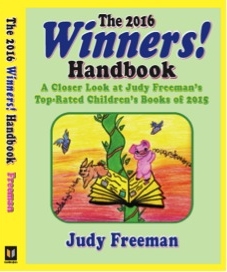
by Judy Freeman
Bound to Stay Bound Books, ©2016.
Paperback $35.00} Includes shipping & handling
Judy Freeman's latest comprehensive handbook--her best yet, weighing in at 285 pages-- includes Judy's 128 best books of 2015, teachers' lesson plans, kids' work, songs, stories, lists, ideas galore, and a full index. This handbook was developed to go with her 32nd Annual Winners! Workshop that she presented across New Jersey in May 2016. If you can't make it to Judy's Winners! Workshop or one of her "What's New in Children's Literature seminars for BER (Bureau of Educational Research; www.ber.org), this all-new edition of The Winners! Handbook is a mighty good substitute. The 2016 Winners! Handbook is available exclusively from Bound to Stay Bound Books (www.btsb.com/judy-freeman).
|
|
The 2017 WINNERS! Handbook: |
| A Closer Look At Judy Freeman's | |
| Top-Rated Children's Books of 2016 | |
| by Judy Freeman | |
| Bound to Stay Bound Books, ©2017. | |
| Order directly from the publisher.
http://www.btsb.com/judy-freeman
Includes shipping & handling |
Judy Freeman's latest comprehensive handbook is an invaluable resource for librarians, classroom teachers, reading specialists, BSI teachers, Gifted & Talented teachers, and all who love children's literature. It includes Judy's 128 best books of 2016, teachers' lesson plans, kids' work, songs, stories, lists, ideas galore, and a full index. This handbook was developed to go with her 33rd Annual Winners! Workshop that she presented across New Jersey in May 2017. If you can't make it to Judy's Winners! Workshop or one of her "What's New in Children's Literature seminars for BER (Bureau of Educational Research; www.ber.org), this all-new edition of The Winners! Handbook is a mighty good substitute. The 2017 Winners! Handbook is available exclusively from Bound to Stay Bound Books (www.btsb.com/judy-freeman).
(Paperback); $35.00 Includes shipping & handling
Back to Top